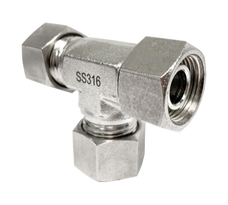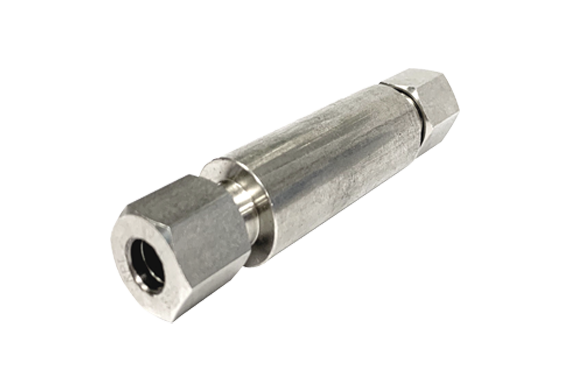|
|
|
Material Specification |
|
Connection Type |
|
Size |
|
Working Pressure |
|
Complete set components |
|
DIN Fittings are designed according to the Deutsches Institut fϋr Normung DIN 2353 / ISO 8434-1 standard. DIN fitting is being called as compression single ferrule fittings which are used to connect thin-walled pipes or tubes. They are also referred to as tube connectors or DIN type tube fittings. They are used in hydraulic systems to ensure a leakage-free flow during operation.
These fittings are produced in three different series – S, LL, and L series. S series are used for high pressure systems, LL for very light pressure, and L for light pressure. They serve as a form of protector for pipes and tubes working under high pressure. The working pressure for the DIN fitting ranges from 100 to 800 bars and it uses compression end and bite type connection types.
These fittings are produced in three different series – S, LL, and L series. S series are used for high pressure systems, LL for very light pressure, and L for light pressure. They serve as a form of protector for pipes and tubes working under high pressure. The working pressure for the DIN fitting ranges from 100 to 800 bars and it uses compression end and bite type connection types.
|
|
STUDY CATALOGUE HERE |
|
1. What is DIN Fitting?
|
DIN fittings or compression ferrule fittings are used to join two pipes or tubes together. In cases where the pipes or tubes to be connected have thin walls or different materials, a compression single ferrule fitting is one of the fitting tools that could provide a solution. For instance, when two pipes made with copper and stainless steel are to be joined, there’s a need for customized fitting to make them compatible and ensure a smooth flow of fluid. DIN fittings are compression fittings with the addition of ferrule (iron) in them.
DIN Fittings are produced in a variety of sizes for flexibility. The sizes of these fittings are a minimum of 4mm to a maximum of 42mm. The working pressure of these compression fittings ranges from 100 to 800 bars. The fittings are manufactured in Germany and Korea. The brand name is Eaton and HSME. The well-known brand is from the USA named Parker. |
2. How are DIN Fittings measured?
DIN fittings can withstand high working pressure. Due to the incessant running of the fitting in the system, strength is needed for a long and smooth running of flow. The maximum working pressure of DIN fittings is 800 bar or 11,600 PSI. They are designed in three series – S, L, and LL. S series can withstand working pressure between 315 to 630 bars. L series work under pressure of 160 bar or 315 bar. The minimum pressure for compression fittings is 100 bars and it only applies to the LL series.
Here's a summary table:
Here's a summary table:
|
|
Compression or DIN fittings are configured into different types. This is to ensure the fittings are useful in different situations. The common fittings are straight and used for connections of straight pipes and hoses. Other available configurations are crosses, tees, nuts, plugs, and caps.
3. What is DIN Fitting material?
|
DIN fittings can be made of several materials that increase its versatility for usage. The materials are brass, carbon steel, zinc, and stainless steel SS316. These materials are used for compatible systems.
Brass Fittings: Brass materials are one of the common materials for the manufacturing of pipes and tubes. It has gained more relevance because of its topic qualities and dynamic features. Asides from Compression fittings, brass are used for ballcock adapters, air brakes, fuel line valves, refrigerator cooler fittings, and many more. The benefits of the brass fittings are:
|
Carbon Steel Fitting: Carbon steel is an element that contains iron, carbon, manganese, copper, silicon, sulfur, phosphorus, molybdenum, nickel, chromium, and vanadium. Carbon steel is simply steel with an addition of carbon. Carbon is added to the element to increase its strength. Carbon steel is mostly preferred in fittings because:
Stainless Steel Fittings: Stainless Steel is another material used in producing different system components and fittings. Stainless steel contains chromium, sulfur, nitrogen, copper, selenium, aluminium, silicon, nickel, and molybdenum. Some of the benefits of stainless steel in fittings are:
- Strength: The carbon contained in the material and the heat treatment of the semi-finished product is exposed to contribute to the high strength quality of the carbon steel. This has classified carbon steel fittings as one of the most durable products.
- Resistance: Carbon steel fittings are resistant to several factors like harsh environmental factors, corrosion, etc. this corrosion resistance makes the fittings easy to clean and maintain.
Stainless Steel Fittings: Stainless Steel is another material used in producing different system components and fittings. Stainless steel contains chromium, sulfur, nitrogen, copper, selenium, aluminium, silicon, nickel, and molybdenum. Some of the benefits of stainless steel in fittings are:
- Resistance to Corrosion and Chemical Damage: Stainless steel contains a minimum of 11% chromium which makes it resistant to corrosion. It can also be exposed to chemicals without deformation or breaking risk.
- Easy availability: Stainless steel fittings are very flexible, and this makes them readily available in the market for purchase.
4. What items do you need before connecting tubes and fittings?
Before connecting fittings to tubes or pipes, you have to be adequately prepared for the process. More so, the components to be joined needs to be readily available and carefully chosen. Follow these steps to prepare your components:
|
Step 1: Tubes
Before buying your tubes, you have to understand the need for compatibility of materials. Select the tubes with particular reference to working pressure, chemical composition, size, temperature range, etc. Step 2: Fittings Select the preferred fitting configuration to use. Fittings are important components that decide the direction of flow according to their shapes. You can use union coupling, tee, 90D, elbow, or other fitting types. Step 3: Tools When choosing tools, you have to consider the outer diameter size of the tubes bought. The right tools will allow a quick and smooth installation process. |
5. How to assemble DIN Fitting in the correct way?
For compression single ferrule DIN fittings, attention has to be placed on the assembly process as it dictates the effectiveness and performance of the fittings. Fortunately, the fittings are designed with a robust tube grip which makes the installation and disassembly process quite easy. Also, the fittings can work under high pressures, weather changes, and withstand vibration fatigue.
With the right items in place already, follow the following steps for installation:
STEP 1
Place the cutting ring and nut over the tube in the right position
STEP 2
Insert the tube in the pre-assembly tool reaching the tube abutment before using the nut to hand tighten the tubes.
STEP 3
Use a wrench to tighten 1 1/4 turns over the hand tightened position.
STEP 4
Remove the pre-assembly and nut to see the formation of the ring over the tube. The ring formation happens as a result of the cutting ring penetration into the tube surface.
STEP 5
Tighten the nut with a wrench whilst the fitting body is standing firmly. When a torque increase is observed, tighten the nut ¼ turn as the last step. However, note that the body shouldn’t be turned, only nuts.
With the right items in place already, follow the following steps for installation:
STEP 1
Place the cutting ring and nut over the tube in the right position
STEP 2
Insert the tube in the pre-assembly tool reaching the tube abutment before using the nut to hand tighten the tubes.
STEP 3
Use a wrench to tighten 1 1/4 turns over the hand tightened position.
STEP 4
Remove the pre-assembly and nut to see the formation of the ring over the tube. The ring formation happens as a result of the cutting ring penetration into the tube surface.
STEP 5
Tighten the nut with a wrench whilst the fitting body is standing firmly. When a torque increase is observed, tighten the nut ¼ turn as the last step. However, note that the body shouldn’t be turned, only nuts.
COMPRESSION FITTINGS CATALOGUE










